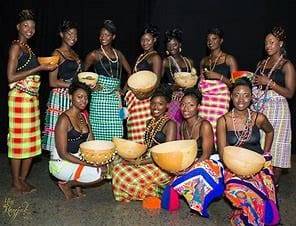Guinea-Bissau officially the Republic of Guinea-Bissau is a country in West Africa that covers 36,125 square kilometres (13,948 sq mi) with an estimated population of 1,874,303. It borders Senegal to the north and Guinea to the south-east. Guinea-Bissau was once part of the kingdom of Kaabu, as well as part of the Mali Empire.
Only about 2% of the population speaks Portuguese, the official language, as a first language, and 33% speak it as a second language. However, Creole is the national language and also considered the language of unity. According to a 2012 study, 54% of the population speak Creole as a first language and about 40% speak it as a second language. The remainder speak a variety of native African languages. There are diverse religions in Guinea-Bissau. Christianity and Islam are the main religions practised in the country. The country’s per-capita gross domestic product is one of the lowest in the world.

The Block

Guinea-Bissau boasts a strong tradition of weaving and tie-dyeing colourful woven cottons. As the skillful hands of weavers work the narrow strips of cloth, creative, geometric designs begin to emerge, the more intricate of which are used only for special ceremonial clothing. Styles and patterns, which identify specific ethnic groups, may differ throughout the country, but the craft itself is an integral part of the culture that all the tribes share. It is even featured on Guinea-Bissau’s 1000-peso banknote, which shows a man weaving a pano de banda (sash). Men and the older generation of both genders traditionally wear garments with a length of fabric draped over one shoulder. Women often adapt the cloth to make skirts. This block features a wonderful example of Guinean weaving in which the rich gold and black fabric, contributed by Molly Kane, has been creatively folded to highlight its elaborate patterns.
WOVEN TEXTILE

More than clothes, textile which was used as currency also convey messages and aesthetic. Social acknowledgement sign, means of cultural expression in lot of regions, african fabric is nowadays promoted in worldwide catwalk through wax fabric; but the supply is wider. Let’s have an overview of the large family of afro textile: woven vs patterned.
Faso dan fani

Faso Dan FaniTraditional cotton fabric from Burkina Faso, weaved on a tiny weaving loom; its production was developed with the accession of new president Thomas Sankara in 1983.
Bogolan

Malian identity representative, bogolan, « did with soil » in Bambara (common language from Mali), is weaved and coloured with natural pigment.
Kente or Kita

Fabric from Akan people (Ghana and Côte d’Ivoire (where it is called kita)), it is produced from cotton and silk.
Kikoy or kikoi

Traditional textile from eastern africa, especially from Kenya, it is known for its warm colour and stripes.
Manjak textile

Manjak fabric is a cotton fabric manufactured manually by a loom. Soft, supple, thick, the loincloth Manjak, also called “Bléénj” is an unequaled beauty. According to legend, it is a spirit that has taught a Manjak man from the village of Kalëkis to weave.
It is worn during the great celebrations, that is to say during a baptism, marriage, birth or funeral. Precisely, men and women tie their own loincloth around their waists.
Originally from different regions, this fabric is not worn in the same way. In addition, colors and patterns vary with age. And, they have their own meanings.
These fabrics have a high symbolic value for the Manjak people. It is a stuff of luxury, true pride and treasure of the family.
Indigo

Originally, indigo is a deep blue tinctorial plant from Western Africa, developed in several pattern according to the region. Plant dye is applied on cotton weaved fabric like bogolan.
Kuba textile

From the center of Democratic republic of the Congo where it is produced by eponymous ethnic group from raffia fibre (a palm tree cousin).
Madras

Originally from India, this fabric found in the caribbean region is from handmade weaving of banana tree thread dyed. To find it stronger, it was thereafter mixed with cotton.
Handira

Originally a traditional berber clothes worn on shoulders, handira is handmade pure wool weaved in Middle Atlas in Morocco. Usually white and adorned with little coin, it is nowadays used as simple interior decoration element.
PATTERNED TEXTILE
Capulana

Traditional fabric from Mozambique and some South-east african countries, it is similar to Kanga fabric but different from the other african textile by its rectangular and colourful cotton structure.
Bazin

Damasked cotton fabric from United kingdom. The legend tells that the first importer (from Mali) found it by chance during a business trip in Germany where it was used for producing tablecloth and curtain. He asked for adding a glossy look to sell it in Africa. Today, Mali is renowned for the production of bazin, so much as the quality than diversity of dying creativity.
Shwe shwe

Brought by German immigrants in South Africa, shwe shwe is today fully part of Xhosa culture (country East side). Geometric patterns, 100% cotton, traditional colours are blue indigo, red and brown.
Chiromani

Two-coloured cotton fabric made of six checks with the same pattern worn by Comorian women. Traditional colours are bright red, black and burgundy.
Shuka Massai

Traditional cotton fabric from Massai (Kenya), bright red and blue, Shuka massai is worn by men around the body and tied on the shoulder. It was highlighted by Kim Jones for Louis Vuitton men spring/summer collection 2012.
Kitenge (Vitenge or Chitenge)

Bright pattern fabric. Similar to wax textile but unlike it, it is lighter. Sometimes, patterns include a sentence (generally a quote). Traditionally worn around the waist or head wrapped in Kenya, Tanzania, Uganda, Malawi….
Kanga

Swahili culture symbol, this traditional cotton fabric from Eastern Africa is rectangular and colourful. Pattern are on the central part of the piece and along the four sides border generally a sentence like Kitenge.
Wax

Industrial colourful patterned batik on cotton fabric, dutch origin, wax is today the most famous african textile.
Article By Harshika Sapra
bibliography
www.quiltofbelonging.ca
afroculture.net
afrolia.com
afroculture.net

